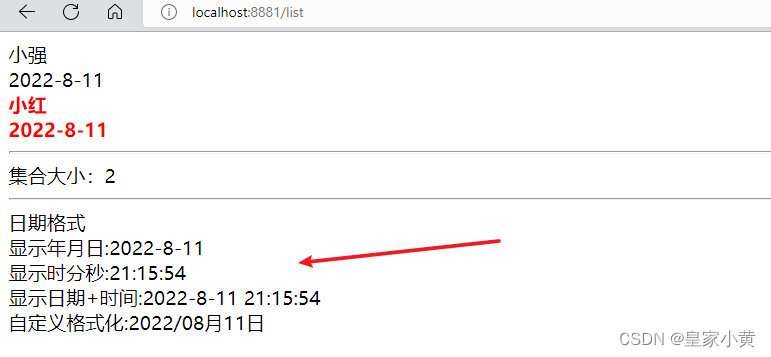FreeMarker快速入门详解
FreeMarker 是一款 模板引擎: 即一种基于模板和要改变的数据, 并用来生成输出文本(HTML网页,电子邮件,配置文件,源代码等)的通用工具。它不是面向最终用户的,而是一个Java类库,是一款程序员可以嵌入他们所开发产品的组件。模板编写为FreeMarker Template Language (FTL)。它是简单的,专用的语言,不是像PHP那样成熟的编程语言。那就意味着要准备数据在真实
freemarker 介绍
FreeMarker 是一款 模板引擎: 即一种基于模板和要改变的数据, 并用来生成输出文本(HTML网页,电子邮件,配置文件,源代码等)的通用工具。 它不是面向最终用户的,而是一个Java类库,是一款程序员可以嵌入他们所开发产品的组件。
模板编写为FreeMarker Template Language (FTL)。它是简单的,专用的语言, 不是 像PHP那样成熟的编程语言。 那就意味着要准备数据在真实编程语言中来显示,比如数据库查询和业务运算, 之后模板显示已经准备好的数据。在模板中,你可以专注于如何展现数据, 而在模板之外可以专注于要展示什么数据。
常用的java模板引擎还有哪些?(面试)
Jsp、Freemarker、Thymeleaf 、Velocity 等。
1.Jsp 为 Servlet 专用,不能单独进行使用。
2.Thymeleaf 为新技术,功能较为强大,但是执行的效率比较低。
3.Velocity从2010年更新完 2.0 版本后,便没有在更新。Spring Boot 官方在 1.4 版本后对此也不在支持,虽然 Velocity 在 2017 年版本得到迭代,但为时已晚。
模板+数据模型=输出
freemarker并不关心数据的来源,只是根据模板的内容,将数据模型在模板中显示并输出文件(通常为html,也可以生成其它格式的文本文件)
1、数据模型
数据模型在java中可以是基本类型也可以List、Map、Pojo等复杂类型。
2、来自官方的例子
环境搭建&&快速入门
freemarker作为springmvc一种视图格式,默认情况下SpringMVC支持freemarker视图格式。
需要创建Spring Boot+Freemarker工程用于测试模板。
在线预览:freemarker作为springmvc一种页面。在浏览器展示
浏览器发起请求---->SpringMVC---->执行Controller----->定义返回值(模板地址)---->模板中绑定数据---->浏览器展示
创建测试工程
这里我就简单介绍一下,要想详细了解大家可以进我发官网去看看
导入依赖
<!-- 添加springboot 父类依赖 -->
<parent>
<groupId>org.springframework.boot</groupId>
<artifactId>spring-boot-starter-parent</artifactId>
<version>2.3.2.RELEASE</version>
</parent>
<dependencies>
<!--添加 spring boot web 依赖-->
<dependency>
<groupId>org.springframework.boot</groupId>
<artifactId>spring-boot-starter-web</artifactId>
</dependency>
<dependency>
<groupId>org.springframework.boot</groupId>
<artifactId>spring-boot-starter-validation</artifactId>
</dependency>
<dependency>
<groupId>org.springframework.boot</groupId>
<artifactId>spring-boot-starter-freemarker</artifactId>
</dependency>
<dependency>
<groupId>org.springframework.boot</groupId>
<artifactId>spring-boot-starter-test</artifactId>
</dependency>
<!-- lombok使用 -->
<dependency>
<groupId>org.projectlombok</groupId>
<artifactId>lombok</artifactId>
<version>1.18.8</version>
<scope>provided</scope>
</dependency>
<!-- apache 对 java io 的封装工具库 -->
<dependency>
<groupId>org.apache.commons</groupId>
<artifactId>commons-io</artifactId>
<version>1.3.2</version>
</dependency>
</dependencies>
配置application.yml配置
spring:
freemarker:
#开启 freemarker 功能
enabled: true
#关闭模板缓存,方便测试
cache: false
settings:
template_update_delay: 0
#页面模板后缀名
suffix: .ftl
charset: UTF-8
#页面模板位置(默认为 classpath:/templates/)
template-loader-path: classpath:/templates/
resources:
#关闭项目中的静态资源映射(static、resources文件夹下的资源)
add-mappings: false
创建模型类;
package com.xuecheng.freemarker.entity;
import lombok.Data;
import lombok.ToString;
import java.util.Date;
import java.util.List;
@Data
@ToString
public class Student {
private String name;//姓名
private int age;//年龄
private Date birthday;//生日
private Float money;//钱包
}
模拟controller层:
package com.xuecheng.test.freemarker.controller;
import org.springframework.beans.factory.annotation.Autowired;
import org.springframework.stereotype.Controller;
import org.springframework.web.bind.annotation.RequestMapping;
import org.springframework.web.client.RestTemplate;
import java.util.Map;
@Controller
public class HelloController {
@GetMapping("basic")
public String test(Model model) {
//1.纯文本形式的参数
model.addAttribute("name", "freemarker");
//2.实体类相关的参数
Student student = new Student();
student.setName("小明");
student.setAge(18);
model.addAttribute("stu", student);
return "01-basic";
}
}
创建模板
在resources下创建templates,此目录为freemarker的默认模板存放目录。
在templates下创建模板文件 01-basic.ftl ,模板中的插值表达式最终会被freemarker替换成具体的数据。
<!DOCTYPE html>
<html>
<head>
<meta charset="utf-8">
<title>Hello World!</title>
</head>
<body>
<b>普通文本 String 展示: Hello ${name}</b><br><br>
<br>
<hr>
<b>对象Student中的数据展示:${stu}</b><br/>
姓名:${stu.name}<br/>
年龄:${stu.age}
<hr>
</body>
</html>
支持EL表达式

页面上的指令,基本语法规则
基础语法种类:
1.注释,即<#-- -->,介于其之间的内容会被freemarker忽略
<#--我是一个freemarker注释-->

2、插值(Interpolation):即 ${..} 部分,freemarker会用真实的值代替${..}
Hello ${name}

3、FTL指令:和HTML标记类似,名字前加#予以区分,Freemarker会解析标签中的表达式或逻辑。
<#>FTL指令</#>
@GetMapping("/list")
public String list(Model model) {
//响应数据
//2.1 小强对象模型数据
Student stu1 = new Student();
stu1.setName("小强");
stu1.setAge(18);
stu1.setMoney(1000.86f);
//2.2 小红对象模型数据
Student stu2 = new Student();
stu2.setName("小红");
stu2.setMoney(200.1f);
stu2.setAge(19);
//2.3 将两个对象模型数据存放到List集合中
List<Student> stus = new ArrayList<>();
stus.add(stu1);
stus.add(stu2);
model.addAttribute("stus",stus);
<!DOCTYPE html>
<html>
<head>
<meta charset="utf-8">
<title>Hello World!</title>
</head>
<body>
<b>展示list中的stu数据:</b>
<br>
<br>
<#--list 数据的展示-->
<b>展示list中的stu数据:</b>
<#list stus as s>
name:${s.name},
age:${s.age},
money:${s.money},
</#list>
<hr>
</body>
</html>

4、文本,仅文本信息,这些不是freemarker的注释、插值、FTL指令的内容会被freemarker忽略解析,直接输出内容.
<#--freemarker中的普通文本-->
我是一个普通的文本

集合指令(List和Map)
@GetMapping("/list")
public String list(Model model) {
//响应数据
//2.1 小强对象模型数据
Student stu1 = new Student();
stu1.setName("小强");
stu1.setAge(18);
stu1.setMoney(1000.86f);
//2.2 小红对象模型数据
Student stu2 = new Student();
stu2.setName("小红");
stu2.setMoney(200.1f);
stu2.setAge(19);
//2.3 将两个对象模型数据存放到List集合中
List<Student> stus = new ArrayList<>();
stus.add(stu1);
stus.add(stu2);
model.addAttribute("stus",stus);
//3. 创建Map数据
Map<String,Student> stuMap = new HashMap<>();
stuMap.put("stu1",stu1);
stuMap.put("stu2",stu2);
model.addAttribute("stuMap", stuMap);
//返回模板地址
return "02-collection";
}
<!DOCTYPE html>
<html>
<head>
<meta charset="utf-8">
<title>Hello World!</title>
</head>
<body>
<b>展示list中的stu数据:</b>
<br>
<br>
<#--list 数据的展示-->
<b>展示list中的stu数据:</b>
<#list stus as s>
name:${s.name},
age:${s.age},
money:${s.money},
</#list>
<hr>
<b>展示map中的数据:</b>
<#--获取map中某个key下的数据:map.key.属性-->
stu1的name:${stuMap.stu1.name}<br>
stu2的name:${stuMap.stu2.name}<br>
<#--遍历map集合,获取map中的所有数据
语法:[map]?keys as key -- 循环map集合获取获取每个key
-->
<hr>
遍历map集合 <br>
<#--<#list stuMap?keys as key>-->
<#-- ${stuMap[key].name} -- ${stuMap[key].age} <br>-->
<#--</#list>-->
<#list stuMap? keys as key>
${stuMap[key].name} ---- ${stuMap[key].age}-----${stuMap[key].money}<br>
</#list>
</body>
</html>

${k_index}:
index:得到循环的下标,使用方法是在stu后边加"_index",它的值是从0开始


if指令
if 指令即判断指令,是常用的FTL指令,freemarker在解析时遇到if会进行判断,条件为真则输出if中间的内容,否则跳过内容不再输出。
<#--格式-->
<#if condition>
...
<#elseif condition2>
...
<#elseif condition3>
...
...
<#else>
...
</#if>
package com.example;
import org.springframework.beans.factory.annotation.Autowired;
import org.springframework.stereotype.Controller;
import org.springframework.ui.Model;
import org.springframework.web.bind.annotation.GetMapping;
import org.springframework.web.bind.annotation.RequestMapping;
import org.springframework.web.client.RestTemplate;
import java.util.*;
@Controller
public class HelloController {
@GetMapping("basic")
public String test(Model model) {
//1.纯文本形式的参数
model.addAttribute("name", "freemarker");
//2.实体类相关的参数
Student student = new Student();
student.setName("小明");
student.setAge(18);
model.addAttribute("stu", student);
return "01-basic";
}
@GetMapping("/list")
public String list(Model model) {
//响应数据
//2.1 小强对象模型数据
Student stu1 = new Student();
stu1.setName("小强");
stu1.setAge(18);
stu1.setMoney(1000.86f);
//2.2 小红对象模型数据
Student stu2 = new Student();
stu2.setName("小红");
stu2.setMoney(200.1f);
stu2.setAge(19);
//2.3 将两个对象模型数据存放到List集合中
List<Student> stus = new ArrayList<>();
stus.add(stu1);
stus.add(stu2);
model.addAttribute("stus",stus);
//3. 创建Map数据
Map<String,Student> stuMap = new HashMap<>();
stuMap.put("stu1",stu1);
stuMap.put("stu2",stu2);
model.addAttribute("stuMap", stuMap);
//返回模板地址
return "03-if";
}
}
<!DOCTYPE html>
<html>
<head>
<meta charset="utf-8">
<title>Hello World!</title>
</head>
<body>
<#list stus as s>
<#if s.name='小红'>
<b style="color: red">
${s.name}<br>
</b>
<#elseif s.name='小绿'>
<b style="color: green">
${s.name}<br>
</b>
<#--类似于swich中的default-->
<#else>
${s.name}<br>
</#if>
</#list>
</body>
</html>

空值处理:
Freemarker 在显示数据时,如果遇到了null或空,Freemarker就会在显示页面中报出错误信息:null or missing,
Freemarker中需要对空值间判断,判断后的数据就不会显示错误信息。
判断某变量是否存在使用 “??”
如:为防止stus为空报错可以加上判断如下:
<#if stus??>
<#list stus as stu>
......
</#list>
</#if>
缺失变量默认值使用 “!”**
使用!要以指定一个默认值,当变量为空时显示默认值
如:${name!''}表示如果name为空显示空字符串。
实际例子:
<!DOCTYPE html>
<html>
<head>
<meta charset="utf-8">
<title>Hello World!</title>
</head>
<body>
<#list stus as s>
<#if s??>
<#if s.name='小红'>
<b style="color: red">
${s.name}<br>
${s.birthday!'2022-8-11'}<br>
</b>
<#elseif s.name='小绿'>
<b style="color: green">
${s.name}<br>
${s.birthday!'2022-8-11'}<br>
</b>
<#else>
${s.name}<br>
${s.birthday!'2022-8-11'}<br>
</#if>
</#if>
</#list>
</body>
</html>

内建函数
内建函数语法格式: 变量+?+函数名称
- 某个集合的大小
<hr>
集合大小:${stus?size}<br>


-
日期格式化
显示年月日:
${today?date}
显示时分秒:${today?time}
显示日期+时间:${today?datetime}
自定义格式化:${today?string("yyyy年MM月")}

Date date = new Date();
model.addAttribute("today",date);
<hr>
日期格式
<br>
显示年月日:${today?date}<br>
显示时分秒:${today?time}<br>
显示日期+时间:${today?datetime}<br>
自定义格式化:${today?string("yyyy/MM月dd日")}

- 内函数
c
model.addAttribute("point", 102920122);
point是数字型,使用${point}会显示这个数字的值,每三位使用逗号分隔。
如果不想显示为每三位分隔的数字,可以使用c函数将数字型转成字符串输出

model.addAttribute("point", 102920122);
<hr>
内函数:<br>
有c:${point?c}<br>
无c:${point}

静态化测试(练习)
之前的测试都是SpringMVC将Freemarker作为视图解析器(ViewReporter)来集成到项目中,工作中,有的时候需要使用Freemarker原生Api来生成静态内容并使用文件来存储静态化后的内容,下面一起来学习下原生Api生成文本文件。
使用freemarker原生Api将页面生成html文件,本节测试html文件生成的方法:
1、根据模板文件生成html文件的字符串
模板文件 + 数据模型 = 静态文件
2、根据模板字符串生成静态文件
模板字符串 + 数据模型 = 静态文件
GeneratorHtml.class
package com.example;
import freemarker.template.Configuration;
import freemarker.template.Template;
import org.apache.commons.io.IOUtils;
import org.junit.Test;
import org.springframework.boot.test.context.SpringBootTest;
import org.springframework.ui.freemarker.FreeMarkerTemplateUtils;
import java.io.File;
import java.io.FileOutputStream;
import java.io.InputStream;
import java.util.HashMap;
import java.util.Map;
@SpringBootTest
public class GeneratorHtml {
@Test
public void testHtml() throws Exception {
//1、创建配置类,指定版本信息
Configuration configuration = new Configuration(Configuration.getVersion());
//2、指定模板,字符编码
String path = this.getClass().getResource("/templates").getPath();
configuration.setDirectoryForTemplateLoading(new File(path)); //指定模板文件的文件夹路径
configuration.setDefaultEncoding("utf-8");
//3、获取模板文件
Template template = configuration.getTemplate("01-basic.ftl");
//4、构造数据,必须是一个Map集合
Map data = getData();
//5、根据数据 + 模板文件进行数据填充,得到字符串
String content = FreeMarkerTemplateUtils.processTemplateIntoString(template, data);
//6、将静态化字符串写入到指定文件下
InputStream inputStream = IOUtils.toInputStream(content); //字符串转化为输入流
FileOutputStream outputStream = new FileOutputStream(new File("e:/index.html")); //创建文件
IOUtils.copy(inputStream, outputStream); //输入流写入文件
}
private Map getData() {
Map map = new HashMap();
map.put("name","zjf");
Student student = new Student();
student.setName("王者荣耀");
student.setAge(12);
map.put("student",student);
return map;
}
}
01-basic.ftl
<!DOCTYPE html>
<html>
<head>
<meta charset="utf-8">
<title>Hello World!</title>
</head>
<body>
<#--我是一个freemarker注释-->
<b>普通文本 String 展示:</b><br><br>
Hello ${name1!""}<br>
<hr>
<b>对象Student中的数据展示:</b><br/>
姓名:${student.name}<br/>
年龄:${student.age}
<hr>
</body>
</html>


开放原子开发者工作坊旨在鼓励更多人参与开源活动,与志同道合的开发者们相互交流开发经验、分享开发心得、获取前沿技术趋势。工作坊有多种形式的开发者活动,如meetup、训练营等,主打技术交流,干货满满,真诚地邀请各位开发者共同参与!
更多推荐
 已为社区贡献1条内容
已为社区贡献1条内容





所有评论(0)